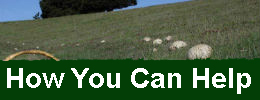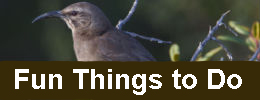After the California Native Plant Society was told that it would not be welcome to bring materials about Knowland Park’s plants and animals to the Zoo’s Earth Day (see http://www.saveknowland.org/2012/03/27/earth-day-at-the-oakland-zoo/) , we decided to share here some of what we might have presented. This is the first in a series on what you WON’T learn about Knowland Park at the Oakland Zoo’s Earth Day. As the designated steward of the park and as an organization that claims the “conservation” mantle, the Zoo should be focusing its conservation message on its own back yard.
A few weeks ago we posted an introduction to the rare maritime chaparral of Knowland Park, one of the many fantastic resources in the park, and one of fewer than a dozen small remnant sites where this plant community can be found in the East Bay hills. California Central Coast Maritime Chaparral is a community of shrubs that grows only within the climatic influence of the ocean and bays, such as San Francisco Bay. (By contrast, interior chaparral grows over a large portion of inland California.) Of the approximately 15,000 acres of parkland in the East Bay hills, maritime chaparral is found on less than one per cent of the area.
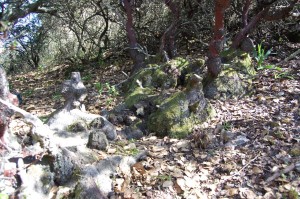
Old, giant burl of Brittleleaf manzanita along a woodland interface. Knowland's maritime chaparral lies along two ridges edged by oak woodland and grassland.
The story of this special plant community is complex: the ancestral genetic plant stock of manzanitas–one of the main indicator shrubs of maritime chaparral– appeared 15 million years ago and covered much of what is now California. How evolution produced today’s remaining maritime chaparral reads like a cosmic cookbook recipe: Take ancient manzanitas. Chill for millions of years, then gradually warm. Apply liberal doses of wildfire and fog. Set beater on “earthquake mode” and shake intermittently over a million years. Pour mixture onto nutrient-poor, permeable crust and voila! maritime chaparral!
If you’re looking for a more scientific explanation of the evolution of maritime chaparral, we suggest reading Mike Vasey’s intriguing and accessible account (http://nrs.ucop.edu/media/transect/spring_2100/fog_factor.html). Vasey, who has studied manzanitas for many years, is currently conducting research on maritime chaparral communities along the central California coast. He dubs these stands “islands in an archipelago”, comparing them to the islands in the Galapagos, birthplace of Darwin’s theory of evolution. Just as Darwin noticed subtle differences in the plants and animals that inhabited each island by virtue of their isolation, Vasey sees these individual stands of maritime chaparral as separate “islands” of speciation. He says, “As an incubator of diversity, maritime chaparral has more in common with tropical rainforest.”
The East Bay hills has small stands of this imperiled plant community, each unique, growing on distinct soil types within microclimes. The northernmost in this archipelago stretching some 20 miles along the spine of the hills occurs at Sobrante Ridge Preserve.
Huckleberry Botanic Preserve, in the mid-range of the hills, is situated almost directly across from the Golden Gate and thus the recipient of more fog than all the others.
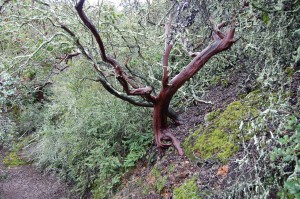
Pallid manzanita growing with huckleberry. A moister microclime at Huckleberry Preserve supports a richer and more diverse understory.
The southernmost and driest site is at Knowland Park. [photo4]
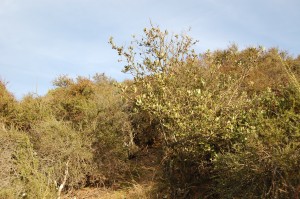
Dense growth of chamise in an exposed dry site at Knowland Park. Note the native needlegrass growing in the foreground and the young coast live oak invading the chaparral.
All of the known sites are at least nominally protected by virtue of being located on either East Bay Regional Park land or East Bay Municipal Utility District watershed land.
Knowland Park contains the only notable site that is unprotected. This site is at extreme risk for destruction by the Zoo’s planned development which poses multiple impacts. First, the 34,000 sq. ft. Administrative (Interpretive) Center will be built into the hillside where the chaparral is located. Because of its chosen location, the Zoo proposes to take out 75% of the chaparral cover in order to reduce the threat of wildfire. In addition, the Zoo plans to erect its aerial gondola directly over the chaparral which will require additional cutting of vegetation to prevent potential wildfire from destroying its equipment. The perimeter fence will run through the chaparral, fragmenting it. There is currently no analysis of the impacts of the road that will have to be cut through the chaparral to allow trucks to carry the fencing equipment to the site for installation.
Finally, there is the impact from invasion of weeds. High quality chaparral stands tend to be dense and impenetrable. Unless the canopy is opened, weeds have a very tough time gaining a foothold. However, once the canopy is opened, weeds can gain a competitive advantage. An example of this invasion is taking place along the fire road across from the cellphone tower. French broom that has moved up the road from the zoo is invading rapidly into the chaparral along the interface.
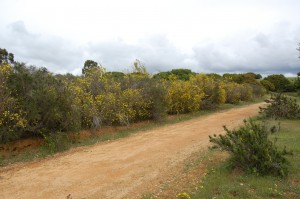
French broom established along the fire road invades the chaparral. Each plant will produce thousands of seeds which can persist in the soil for up to 80 years.
Not far from there, poison hemlock brought in with the manure dumping from the Zoo is penetrating the chaparral at the proposed building site.
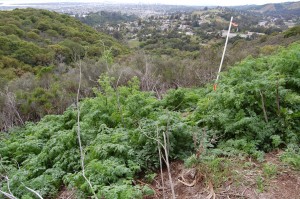
Poison hemlock from dumped manure creates a spreading monoculture along the proposed site for the Interpretive Center.
The losses from these impacts are not mitigable. We cannot create new maritime chaparral–it’s the product of millions of years of evolution. We have already lost untold acres of this precious community to development. Since each site is virtually unique, building on any one of them is destroying forever a living laboratory for study as well as the beauty and richness of our natural heritage.
This Saturday at its Earth Day observance the zoo will exhort the public to preserve precious biodiversity, to write letters and sign petitions in the name of protecting the environment all the while rationalizing and hiding its own destruction of habitat. We challenge the zoo to find a better way to expand than to steal the public trust AND its natural treasures.
 Laura Baker is an environmental activist and former Conservation Chair of the California Native Plant Society. Growing up in Missouri, she learned that the cure for most ills rests in spending time out in nature. She wishes for every child to have the experience of wholeness that nature provides. Laura holds an M.A. in Ecology and Systematic Biology.
Laura Baker is an environmental activist and former Conservation Chair of the California Native Plant Society. Growing up in Missouri, she learned that the cure for most ills rests in spending time out in nature. She wishes for every child to have the experience of wholeness that nature provides. Laura holds an M.A. in Ecology and Systematic Biology.
Laura’s Knowlander blog is dedicated to building an online library of the natural history of Knowland Park so that the public may enjoy the park for the natural heritage treasure that it is. Knowing the land is a never ending process of inquiry open to all. We welcome your comments, contributions, and photos.
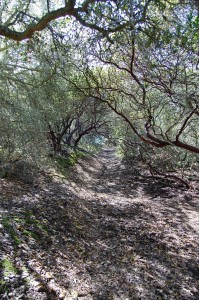
 Follow
Follow


